Sulfur in Plant Nutrition
Diagnosis of Sulfur Nutritional Status
Symptomatology of Single Plants
Visual diagnosis of sulfur deficiency in production fields requires adequate expertise and needs to involve soil or plant analysis (141). The literature describes symptoms of sulfur deficiency as being less specific and more difficult to identify than other nutrient deficiency symptoms (142-145). The symptomatology of sulfur deficiency is very complex and shows some very unique features. In this section, the basic differences in sulfur deficiency symptoms of species in the Gramineae representative of monocotyledonous, and species in the Cruciferae and Chenopodiaceae representative of dicotyledonous crops will be given for individual plants and on a field scale.When grown side by side and under conditions of sulfur starvation, crops begin to develop sulfur deficiency symptoms in the order of oilseed rape (canola), followed by potato, sugar beet (Beta vulgaris L.), beans (Phaseolus vulgaris L.), peas (Pisum sativum L.), cereals, and finally maize. The total sulfur concentration in tissue corresponding to the first appearance of deficiency symptoms is highest in oilseed rape (3.5 mg g-1 S), and lowest in the Gramineae (1.2 mg g-1 S). Potato and sugar beet show symptoms at higher concentrations (2.1 to 1.7 mg g-1 S) than beans or peas (1 to 1.2 mg g-1 S).
Brassica species, such as oilseed rape, develop the most distinctive expression of symptoms of any crop deficient in sulfur. The symptoms are very specific and thus are a reliable guide to sulfur deficiency. There is no difference in the symptomatology of sulfur deficiency in high and low glucosinolate- containing varieties (103). The symptomatology of sulfur deficiency in brassica crops is characteristic during the whole vegetation period and is described below for specific growth stages according to the BBCH scale (146). Symptoms generally apply to dicotyledonous plants, except when specific variations are mentioned in the text. Colored guides of sulfur deficiency symptoms are provided by Bergmann (143) and Schnug and Haneklaus (53,114,147).
Even before winter, during the early growth of oilseed rape, leaves may start to develop visible symptoms of sulfur deficiency. As sulfur is fairly immobile within the plant (13), symptoms always show up in the youngest leaves. Though the plants are still small, symptoms can cover the entire plant. Sulfur fertilization before or at sowing will ensure a sufficient sulfur supply, particularly on light, sandy soils, and will promote the natural resistance of plants against fungal diseases (148).
Oilseed rape plants suffering from severe sulfur deficiency show a characteristic marbling of the leaves. Leaves begin to develop chlorosis (149-154), which starts from one edge of the leaves and spreads over intercostal areas; however, the zones along the veins always remain green (103,155). The reason for the green areas around the veins is most likely the reduced intercellular space in that part of the leaf tissue, resulting in shorter transport distances and a more effective transport of sulfate. Sulfur-deficient potato leaves show the same typical color pattern and veining as oilseed rape, whereas sugar beet, peas, and beans simply begin to develop chlorosis evenly spread over the leaf without any veining (156,157). A comparative evaluation of crop-specific, severe sulfur deficiency symptoms is given in Figure 7.7.
 |
| FIGURE 7.7 Macroscopic sulfur deficiency symptoms of oil seed rape (Brassica napus L.), cereals, and sugar beet (Beta vulgaris L.) at stem extension and row closing, respectively (from left to right). |
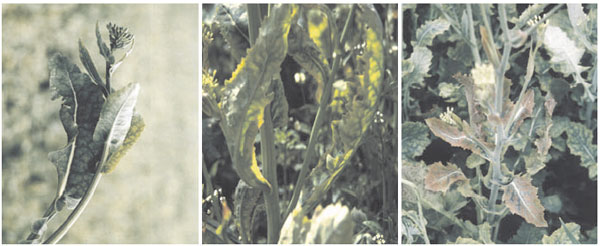 |
| FIGURE 7.8 Marbling, spoon-like leaf deformations and anthocyanin enrichments of sulfur-deficient oilseed rape plants (Brassica napus L.) (from left to right). |
Chlorosis very rarely turns into necrosis (103,157) as it does with nitrogen and magnesium deficiencies, and is an important criterion for differential diagnosis. Even under conditions of extreme sulfur deficiency, an oilseed rape plant will not wither. The intensity of sulfur deficiency symptoms of leaves depends on the nitrogen supply of the plants. In general, a high nitrogen supply promotes the expression of sulfur deficiency symptoms and vice versa (158).
A characteristic secondary symptom of severe sulfur deficiency is a reddish-purple color due to the enrichment of anthocyanins in the chlorotic parts of brassica leaves (Figure 7.8). Under field conditions, the formation of anthocyanins starts 4 to 7 days after chlorosis. The phenomenon is initialized by the enrichment of carbohydrates in the cells after the inhibition of protein metabolism. Plants detoxify the accumulated carbohydrates as anthocyanates, which result from the reaction with cell-borne flavonols to avoid physiological disorders (159-165). Many other nutrient deficiencies are also accompanied by formation of anthocyanins, which therefore is a less specific indicator for sulfur deficiency.
In particular, leaves which are not fully expanded produce spoon-like deformations when struck by sulfur deficiency (Figure 7.8). The reason for this is a reduced cell growth rate in the chlorotic areas along the edge of the leaves, while normal cell growth continues in the green areas along the veins, so that sulfur-deficient leaves appear to be more succulent. The grade of the deformation is stronger the less expanded the leaf is when the plant is struck by sulfur deficiency. Marbling, deformations, and anthocyanin accumulation can be detected up to the most recently developed small leaves inserted in forks of branches (Figure 7.8).
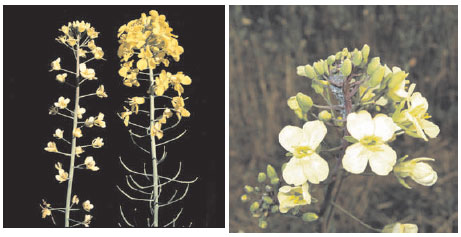 |
| FIGURE 7.9 White flowering (left) and morphological changes of petals (right) of sulfur-deficient oilseed rape (Brassica napus L.). |
The higher succulence of sulfur-deficient plants (143,166) was suspected to be caused by enhanced chloride uptake due to an insufficient sulfate supply (159). However, with an increase of chloride concentrations by 0.4 mg Cl g-1 on account of a decrease of sulfur concentrations by 1 mg g-1 in leaves, this effect seems to be too small to justify the hypothesis (103). More likely, the above-explained mechanical effects of distortion, together with cell wall thickening, cause the appearance of increased succulence due to the accumulation of starch and hemicellulose (167).
During flowering of oilseed rape, sulfur deficiency causes one of the most impressive symptoms of nutrient deficiency: the 'white blooming' of oilseed rape (Figure 7.9). The white color presumably develops from an overload of carbohydrates in the cells of the petals caused by disorders in protein metabolism, which finally ends up in the formation of colorless leuco-anthocyanins (168). As with anthocyanins in leaves, the symptoms develop most strongly during periods of high photosynthetic activity. Beside the remarkable modification in color, size, and shape of oilseed rape, the petals change too (Figure 7.9). The petals of sulfur-deficient oilseed rape flowers are smaller and oval shaped, compared with the larger and rounder shape of plants without sulfur-deficiency symptoms (169). The degree of morphological changes, form, and color, are reinforced by the strength and duration of severe sulfur deficiency (53). The fertility of flowers of sulfur-deficient oilseed rape plants is not inhibited. However, the ability to attract honeybees may be diminished and can be of great importance for the yield of nonrestored hybrids, which need pollination by insect vectors (169).
The strongest yield component affected by sulfur deficiency in oilseed rape is the number of seeds per pod, which is significantly reduced (103). As described earlier for leaves, the branches and pods of S-deficient plants are often red or purple colored due to the accumulation of anthocyanins (Figure 7.10). Extremely low numbers of seeds per pod, in some cases even seedless 'rubber pods,' are characteristic symptoms of extreme sulfur deficiency (Figure 7.10).
Symptomatology of Monocots
The symptoms in gramineous crops such as cereals and corn are less specific than in cruciferous crops. In early growth stages, plants remain smaller and stunted and show a lighter color than plants without symptoms (170). The general chlorosis is often accompanied by light green stripes along the veins (Figure 7.11) (170-172). Leaves become narrower and shorter than normal (173).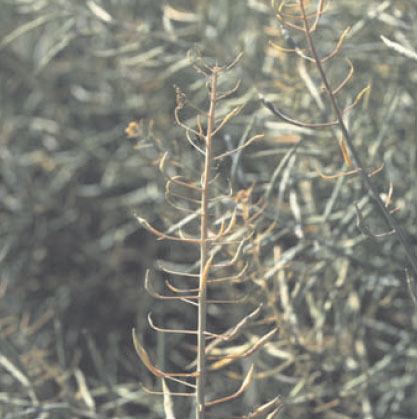 |
| FIGURE 7.10 Enrichment of anthocyanins during ripening of oilseed rape (Brassica napus L.) (left) and reduction of number of seeds per pod (right). |
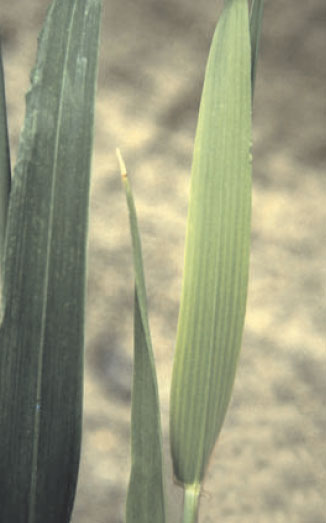 |
| FIGURE 7.11 Macroscopic sulfur deficiency symptoms of winter wheat (Triticum aestivum L.) at stem extension. |
There is no morphological deformation to observe, and usually no accumulation of anthocyanins either. Although the symptoms are very unspecific and are easily mistaken for symptoms of nitrogen deficiency, their specific pattern in fields provides good evidence for sulfur deficiency. Owing to an early reduction of fertile flowers per head, sulfur-deficient cereals are characterized by a reduced number of kernels per head, which alone, however, is not conclusive evidence for sulfur deficiency (174).
Sulfur Deficiency Symptoms on a Field Scale
Some characteristic features in the appearance of fields can provide early evidence of sulfur deficiency. Sulfur deficiency develops first on the light-textured sections of a field. From above, these areas appear in an early oilseed rape crop as irregularly shaped plots with a lighter green color (wash outs). The irregular shape distinguishes the phenomenon from the regular shape of areas caused by nitrogen deficiency, which usually originates from inaccurate fertilizer application (Figure 7.12). Owing to frequent soil compaction and limited root growth, sulfur deficiency develops first along the headlands and tramlines or otherwise compacted areas of a field.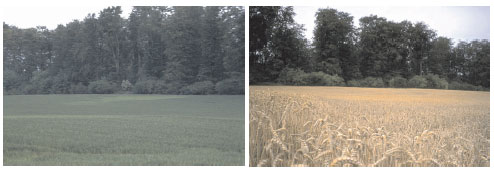 |
| FIGURE 7.12 Chlorotic patches in a field (left) and resultant effects on mature plants (right), indicating severe sulfur deficiency symptoms in relation to soil characteristics. |
The appearance of sulfur-deficient oilseed rape fields is more obvious at the beginning of blooming; white flowers of oilseed rape are distinctively smaller and therefore much more of the green undercover of the crop shines through the canopy of the crop. Another very characteristic indicator of a sulfur-deficient site is the so-called second flowering of the oilseed rape crop. Even if a sulfurdeficient crop has finished flowering, it may come back to full bloom if sufficient sulfur is supplied. The typical situation for this action comes when a wet and rainy spring season up until the end of blooming is followed suddenly by warm and dry weather. During the wet period precipitation, water, which has only one-hundredth to one-tenth the sulfur concentrations of the entire soil solution, dilutes or leaches the sulfate from the rooting area of the plants, so that finally plants are under the condition of sulfur starvation. With the beginning of warmer weather, evaporation increases and sulfur-rich subsoil water becomes available to the plants and causes the second flowering of the crop. During maturity, sulfur deficiency in oilseed rape crops is revealed by a sparse, upright-standing crop.
Similarly, in cereals, sulfur deficiency develops first on light-textured parts of the field, yielding irregularly shaped 'wash-out' areas in images from above. Nitrogen fertilization promotes the expression of these irregularly distributed deficiency symptoms, such as uneven height and color. The irregular shape distinguishes these symptoms from areas caused by faulty nitrogen fertilizer application. In the field, these particular zones can be identified by a green yellowish glow in the backlight before sunset. Later, vegetation in these areas resembles a crop that is affected by drought. Owing to an inferior natural resistance, the heads in sulfur-deficient areas can be infected more severely by fungal disease (e.g., Septoria species), which gives these areas a darker color as the crop matures.




